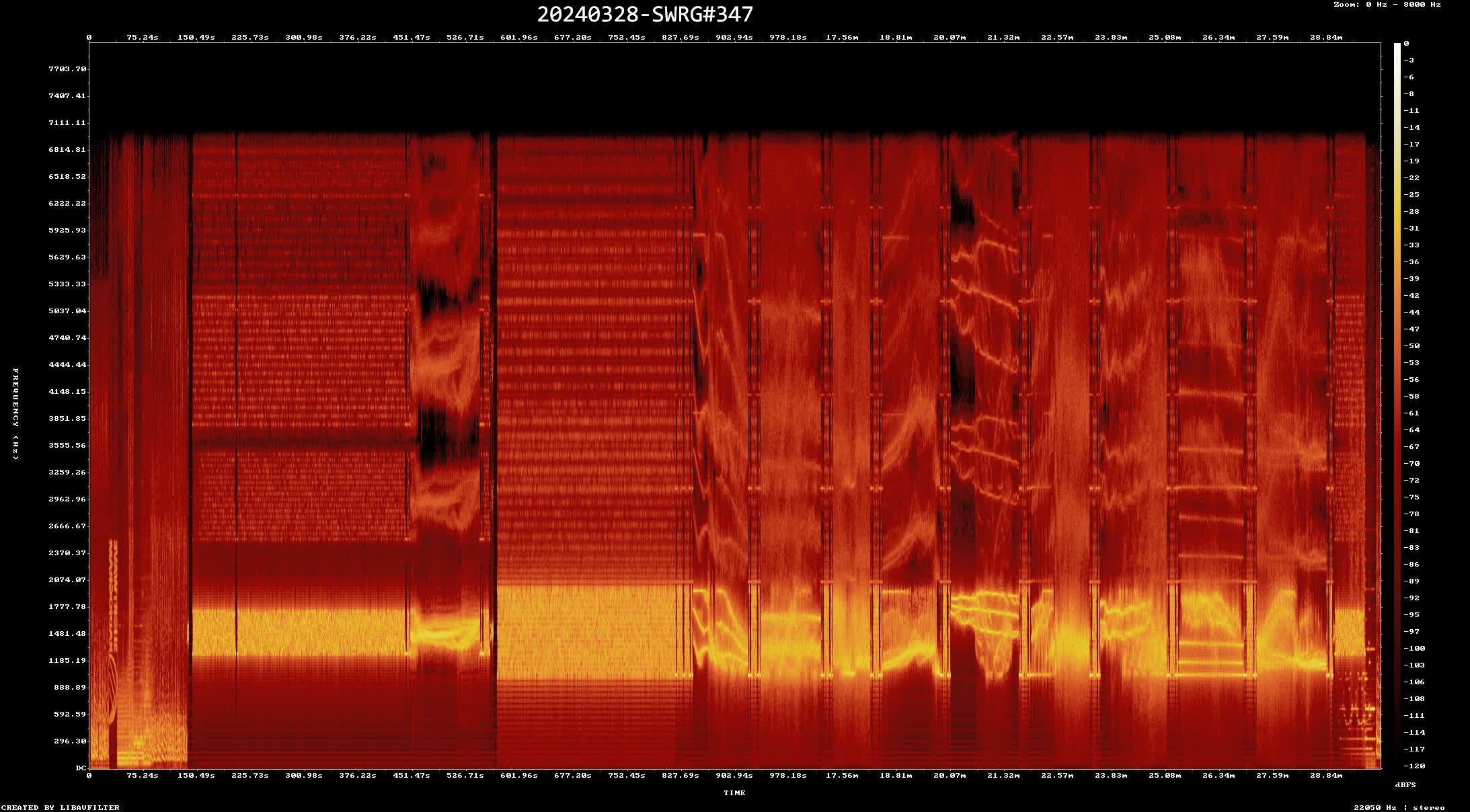
http://www.rhci-online.net/radiogram/radiogram.htm
https://github.com/GyanD/codexffmpeg/releases/tag/2023-03-05-git-912ac82a3c
set MyFiles=*.flac *.fla *.wav *.aif *.mp4 *.mp3 *.mp2 *.aac *.ogg
*.m4a

RSID: <<2024-03-28T23:31Z
MFSK-32 @
9265000+1500>>
Welcome to program 347 of Shortwave Radiogram.
I'm Kim Andrew Elliott in Arlington, Virginia USA.
Here is the lineup for today's program, in MFSK modes as noted:
1:49 MFSK32: Program preview (now)
2:58 MFSK32: Device transmits electricity through window glass*
8:52 MFSK64: NASA rocket will study ionosphere during eclipse
13:13 MFSK64: This week's images*
28:31 MFSK32: Closing announcements
* with image(s)
Please send reception reports to
radiogram@verizon.net
And visit http://swradiogram.net
We're on X/Twitter now: @SWRadiogram
From New Atlas:
No outdoor outlet? Power Mole transmits electricity through
window glass
By Ben Coxworth
March 25, 2024
The Power Mole wirelessly transmits 10 watts of electricity
through window glass, allowing indoor outlets to power outdoor
devices. It's built on the inductive coupling technology utilized
in wireless smartphone charging systems.
Currently the subject of a Kickstarter campaign, the Power Mole
was created by California-based inventor Peter Bevelacqua. It's
made for situations in which devices such as security cameras or
decorative lights need a power source, but there are no outdoor
outlets nearby.
The setup consists of two puck-shaped components: the
transmitter, which is adhered to the inside surface of a window
pane, and the receiver, which is adhered to the outside of the
pane. The transmitter is plugged into an indoor household outlet,
while the receiver is USB hard-wired to the outdoor device.
So, how does it work?
Well, as an alternating electric current passes through an
induction coil in the transmitter, a fluctuating magnetic field
is generated. That field passes through up to 30 mm of glass,
producing an alternating electric current in the receiver's
induction coil. An integrated rectifier converts that AC current
to DC (direct current), which powers the plugged-in gadget.
It's important to note that in its present form, the Power Mole
is limited to use with devices that utilize a USB or 5-volt input
… so no, you can't use it to power your electric drill.
It's also not as energy-efficient as plugging directly into a
wall outlet. Bevelacqua tells us that for powering a device like
a camera – which consumes about 5 watts – the Power Mole's
efficiency ranges from around 50% (at the maximum spacing of 30
mm) up to 75% (at a spacing of less than 6 mm).
That said, if the transmitter is plugged in but can't connect to
the receiver, it automatically shuts off in order to save
electricity. The system also isn't limited to use with glass, as
it can additionally transmit through wood or just about any other
non-metallic material. If metal is detected between the
transmitter and receiver, the transmitter shuts itself off.
Assuming the Power Mole reaches production, a pledge of US$59
will get you a package consisting of a transmitter (with power
cord), receiver, and 3M adhesive pads for both units. The
Kickstarter is limited to US customers, although international
availability should follow if the campaign is a success.
https://newatlas.com/around-the-home/power-mole-transmits-electricity-window-glass/
Sending Pic:176x184C;
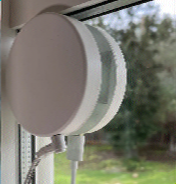
Shortwave Radiogram now changes to MFSK64 ...
RSID: <<2024-03-28T23:38Z
MFSK-64 @
9265000+1500>>
This is Shortwave Radiogram in MFSK64
Please send your reception report to radiogram@verizon.net
From NASA Science:
NASA to Launch Sounding Rockets into Moon's Shadow During Solar
Eclipse
Desiree Apodaca
Mar 25, 2024
NASA will launch three sounding rockets during the total solar
eclipse on April 8, 2024, to study how Earth's upper atmosphere
is affected when sunlight momentarily dims over a portion of the
planet.
The Atmospheric Perturbations around Eclipse Path (APEP) sounding
rockets will launch from NASA's Wallops Flight Facility in
Virginia to study the disturbances in the ionosphere created when
the Moon eclipses the Sun. The sounding rockets had been
previously launched and successfully recovered from White Sands
Test Facility in New Mexico, during the October 2023 annular
solar eclipse. They have been refurbished with new
instrumentation and will be relaunched in April 2024. The mission
is led by Aroh Barjatya, a professor of engineering physics at
Embry-Riddle Aeronautical University in Florida, where he directs
the Space and Atmospheric Instrumentation Lab.
The sounding rockets will launch at three different times: 45
minutes before, during, and 45 minutes after the peak local
eclipse. These intervals are important to collect data on how the
Sun's sudden disappearance affects the ionosphere, creating
disturbances that have the potential to interfere with our
communications. This conceptual animation is an example of what
observers might expect to see during a total solar eclipse, like
the one happening over the United States on April 8, 2024.
The ionosphere is a region of Earth's atmosphere that is between
55 to 310 miles (90 to 500 kilometers) above the ground. "It's an
electrified region that reflects and refracts radio signals, and
also impacts satellite communications as the signals pass
through," said Barjatya. "Understanding the ionosphere and
developing models to help us predict disturbances is crucial to
making sure our increasingly communication-dependent world
operates smoothly."
The ionosphere forms the boundary between Earth's lower
atmosphere - where we live and breathe - and the vacuum of space.
It is made up of a sea of particles that become ionized, or
electrically charged, from the Sun's energy, or solar radiation.
When night falls, the ionosphere thins out as previously ionized
particles relax and recombine back into neutral particles.
However, Earth's terrestrial weather and space weather can impact
these particles, making it a dynamic region and difficult to know
what the ionosphere will be like at a given time.
It's often difficult to study short-term changes in the
ionosphere during an eclipse with satellites because they may not
be at the right place or time to cross the eclipse path. Since
the exact date and times of the total solar eclipse are known,
NASA can launch targeted sounding rockets to study the effects of
the eclipse at the right time and at all altitudes of the
ionosphere.
As the eclipse shadow races through the atmosphere, it creates a
rapid, localized sunset that triggers large-scale atmospheric
waves and small-scale disturbances, or perturbations. These
perturbations affect different radio communication frequencies.
Gathering the data on these perturbations will help scientists
validate and improve current models that help predict potential
disturbances to our communications, especially high frequency
communication.
The APEP rockets are expected to reach a maximum altitude of 260
miles (420 kilometers). Each rocket will measure charged and
neutral particle density and surrounding electric and magnetic
fields. "Each rocket will eject four secondary instruments the
size of a two-liter soda bottle that also measure the same data
points, so it's similar to results from fifteen rockets, while
only launching three," explained Barjatya. Three secondary
instruments on each rocket were built by Embry-Riddle, and the
fourth one was built at Dartmouth College in New Hampshire.
In addition to the rockets, several teams across the U.S. will
also be taking measurements of the ionosphere by various means. A
team of students from Embry-Riddle will deploy a series of
high-altitude balloons. Co-investigators from the Massachusetts
Institute of Technology's Haystack Observatory in Massachusetts,
and the Air Force Research Laboratory in New Mexico, will operate
a variety of ground-based radars taking measurements. Using this
data, a team of scientists from Embry-Riddle and Johns Hopkins
University Applied Physics Laboratory are refining existing
models. Together, these various investigations will help provide
the puzzle pieces needed to see the bigger picture of ionospheric
dynamics.
When the APEP sounding rockets launched during the 2023 annular
solar eclipse, scientists saw a sharp reduction in the density of
charged particles as the annular eclipse shadow passed over the
atmosphere. "We saw the perturbations capable of affecting radio
communications in the second and third rockets, but not during
the first rocket that was before peak local eclipse" said
Barjatya. "We are super excited to relaunch them during the total
eclipse, to see if the perturbations start at the same altitude
and if their magnitude and scale remain the same."
The next total solar eclipse over the contiguous U.S. is not
until 2044, so these experiments are a rare opportunity for
scientists to collect crucial data.
https://science.nasa.gov/solar-system/skywatching/nasa-to-launch-sounding-rockets-into-moons-shadow-during-solar-eclipse/
This is Shortwave Radiogram in MFSK64
Please send your reception report to radiogram@verizon.net
This week's images ...
Fishing boats at sunset in Zhoushan, Zhejiang province, China,
March 20.
https://tinyurl.com/27h85kxf ...
Sending Pic:125x205C;

A kayaker on the Chicago River, dyed green for St. Patrick's Day
celebrations, March 16.
https://tinyurl.com/2xgwjao3 ...
Sending Pic:140x201C;
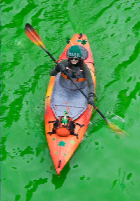
Training on the River Thames in London for the Oxford vs
Cambridge boat race.
https://tinyurl.com/2bfslnas ...
Sending Pic:349x150;
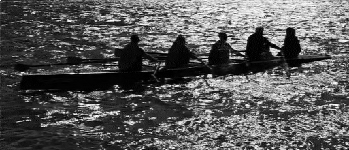
Lava flows and smoke plumes are illuminated by the northern
lights in Grindavík, Iceland.
https://tinyurl.com/2cp2qzlw ...
Sending Pic:201x133C;

An escaped beach ball and its reflection.
https://tinyurl.com/28aqv62l ...
Sending Pic:158x201C;

Spring wildflower blooms at Anza-Borrego Desert State Park in
southern California.
https://tinyurl.com/2ynvnlgl ...
Sending Pic:192x142C;

The Chicago skyline at sunrise, March 25.
https://tinyurl.com/24s7khn5 ...
Sending Pic:158x196C;

A passenger jet flies north in fron of a nearly full moon over
Washington DC.
https://tinyurl.com/27xoczjo ...
Sending Pic:199x152C;

Our painting of the week is "Evening, Akershus" (1913) by Harald
Oskar Sohlberg (Norwegian, 1869-1935).
https://tinyurl.com/2d6sups6 ...
Sending Pic:214x152C;

Shortwave Radiogram returns to MFSK32 ...
RSID: <<2024-03-28T23:58Z
MFSK-32 @
9265000+1500>>
This is Shortwave Radiogram in MFSK32 ...
Shortwave Radiogram is transmitted by:
WRMI, Radio Miami International, wrmi.net
and
WINB Shortwave, winb.com
Please send reception reports to
radiogram@verizon.net
And visit http://swradiogram.net
Twitter: @SWRadiogram or
twitter.com/swradiogram
I'm Kim Elliott. Please join us for the next Shortwave
Radiogram.
|
https://jadquir.xyz/pages/mra/index.html#about SWRG#347 closing song:https://www.shazam.com/song/459229963/son-of-god-mass-lava-me
Son of God Mass: Lava me https://en.wikipedia.org/wiki/James_Whitbourn (17 August 1963 – 12 March 2024) was a British composer and conductor. "...In 2011, The Williamson Voices released the second Naxos choral disc, Living Voices with the Saxophonist Jeremy Powell, and Organist Ken Cowan under conductor James Jordan. "
|
http://www.rhci-online.net/radiogram/radiogram.htm
|
QTH: |
D-06193 Petersberg (Germany/Germania) |
|
|
Ant.: |
Dipol for 40m-Band & Boomerang Antenna 11m-Band |
|
|
RX for RF: |
FRG-100B + IF-mixer & ICOM IC-R75 + IF-mixer |
|
|
Software IF: |
con STUDIO1 - Software italiano per SDR on Windows 11 [S-AM-USB/LSB] + HDSDR 2.81 beta6 - for scheduled IF-recording |
|
|
Software AF: |
Fldigi-4.1.26 + flmsg-4.0.20 images-fldigifiles on homedrive.lnk |
|
|
OS: |
Mirosoft Windows 11 Home |
German W7 32bit + 64bit |
|
PC: |
ASUS S501MD (since 2023) [i7-12700 12th Gen. 12 x 2100 MHz] |
MSI-CR70-2MP345W7 (since 2014) [i5 -P3560 ( 2 x 2600 MHz) ] |
http://wiki.radioreference.com/index.php/Decoding_the_SW_Radiogram_Broadcasts
https://www.qsl.net/ve7vv/Files/Digital%20Modes.pdf
RSID: <<2024-03-
29T11:30Z MFSK-64 @ 15770000+1500>>
Eric Clapton was born on March 30, 1945.
Sending Pic:179x240;

Please report your decode to
themightykbc@gmail.com.
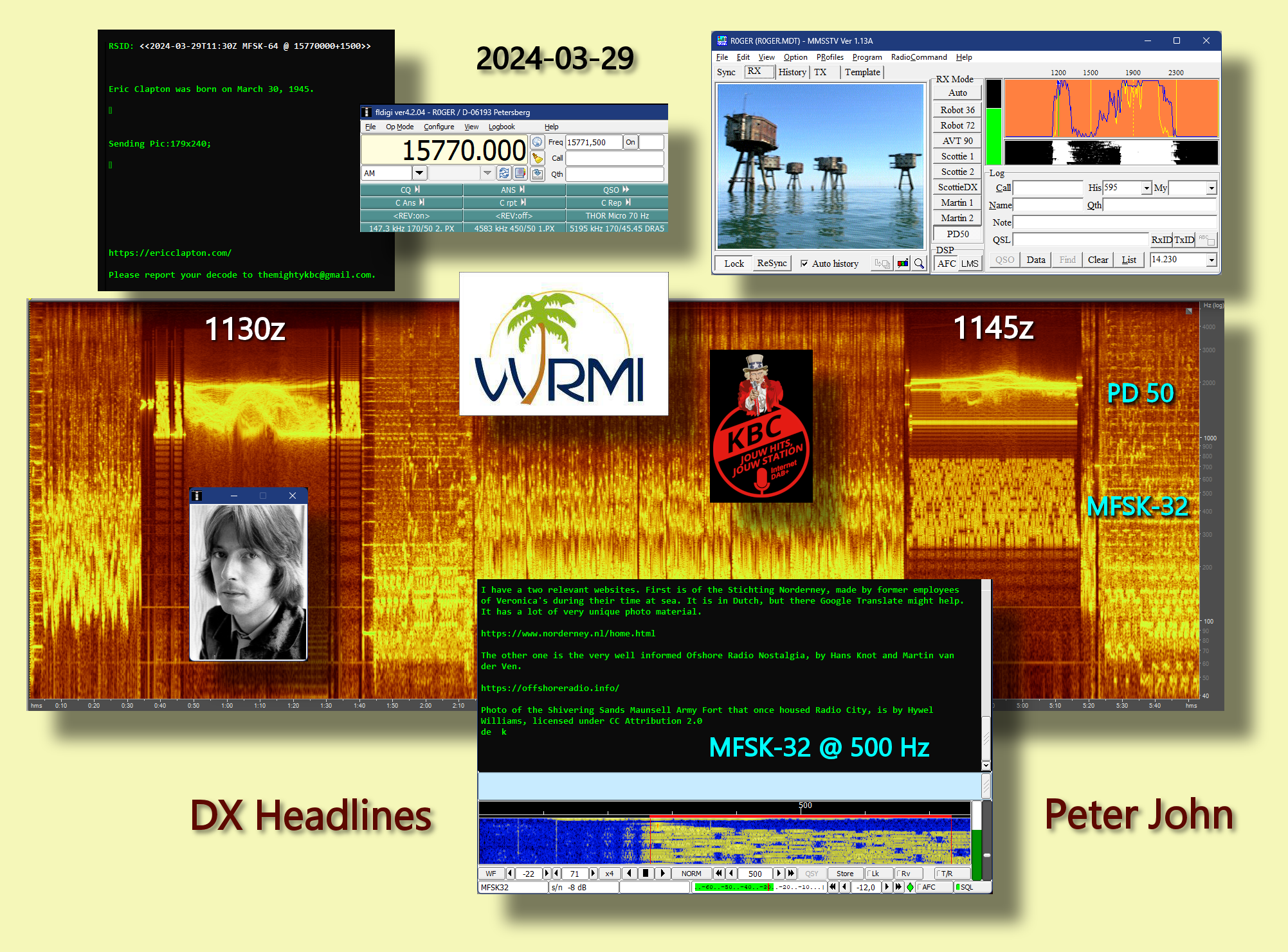
http://www.rhci-online.net/html/RCAR-17W.html

https://app.box.com/s/kbdxb4c5lwpju0kpoi27aiwc35br2g2a
HFZone WRMI-B23 Human Readable SKedGrid ++